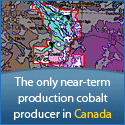
Cobalt:
The Essential Resource of the New Millennium
Just as gas powered autos have depended on oil for the past 100 years, the world’s future fleet of electric vehicles may very well depend on a strategic element mined in a primary capacity in only a handful of locations. This essential element is cobalt.
Cobalt (Co) is a hard, lustrous, silver-grey metal that based on its unique properties has many applications. Although cobalt has been used since ancient times to impart a rich blue colour to glass, glazes and ceramics, it wasn’t until 1735 that the free metallic form was prepared and discovered. Since then, the applications have been varied and the element has played a significant role in industrial uses, the hi-tech industry, medical uses, environmental operations and strategic purposes.
There has been growing momentum in recent years around environmental sustainability and as the socio-economical impact of environmental issues rises, green initiatives have become a global focus.
Cobalt is an element of critical importance to the future energy economy due to its critical role in rechargeable Lithium-ion batteries. The primary use of these batteries is in Hybrid Electric Vehicles (HEVs). Due to escalating gas prices and concerns around fossil fuels more and more nations have recognized the importance of HEV production. HEVs not only reduce air pollution but also cut back on fuel consumption by more than 50% compared to conventional vehicles. This trend has increased HEV production on a global scale with an estimated 8 million units by 2015, thereby increasing annual cobalt demand by nearly 22,000 tonnes/year. The HEV also offers a more environmentally friendly “plug-in” which includes an extra Cobalt-bearing battery, further increasing cobalt demand.
Although some primary Cobalt operations do exist, supply generally comes from the byproduct of Nickel and Copper production and has varying degrees of cost dynamics. A large portion of Cobalt is produced in the Democratic Republic of Congo (DRC) and Zambia as such a byproduct. Puget Venture’s Werner West Cobalt mine is one of the few cobalt resources aiming to be a primary cobalt operation. Werner West is located in the geo-politically stable and progressive jurisdiction of Ontario, Canada.
Puget Ventures has strategically positioned itself in the forefront of the Cobalt industry to supply the growing demand for this essential resource in the near future.
COBALT AT A GLANCE
Chemical Symbol Co
Atomic Number 27
Description Transition Metal
Properties Shiny, grey, brittle metal
Atomic Weight 58.9332
Density (g/cm2) 8.90
Melting Point (K) 1768
Boiling Point (K) 3201
Av. Abundance 25 ppm
UNIQUE PROPERTIES MAKE COBALT AN ESSENTIAL ELEMENT
- High melting point (1493 *C) and retains its strength to a high temperature
Applications: Cutting tools, superalloys, surface coating, high speed steels, cemented carbides, diamond tooling
- Ferromagnetic (nickel and iron are as well) and retains this property to 1100*C, a higher temperature (Curie Point0 than any other material
Applications: Alnico magnets, recording tape, soft magnetic materials, saarium cobalt, NdBFe + cobalt
- Produces intense blue colours when with silica
Applications: Cobalt Blue in paints, glazes, enamels, etc.
- Multivalent
Applications: Catalytic action is enhanced –OXO reaction, Fischer-Tropsch, oil desulphurisation, paint and ink drier, tire adhesives
Cobalt’s green applications extend beyond rechargeable batteries and hybrid vehicles and into the following sectors:
- Renewable Energy
– solar panel technology
– wind generation (turbine blades),
- Emissions Control
– oil desulphurization
– gas to liquid technology
- Digital Revolution
– Cell phones and PDAs
– Computers and electronics
Article Contributed by:
 Click on either banner or HERE for more information.
Click on either banner or HERE for more information.

